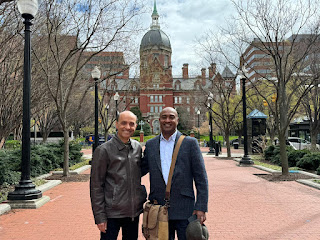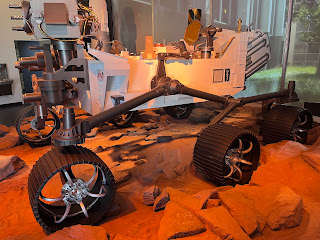Re visiting the foot prints
April 2024 is a memorable month in my sabbatical. Not only did I have the privilege of reconnecting with numerous collaborators, friends, and colleagues across the East and West Coasts of the US, but I also dipped myself in nostalgia of revisiting locations that hold a special place in my heart.
Baltimore
On 5th April, the Department of Biomedical Engineering (BME) of Johns Hopkins University (JHU) celebrated the 60th anniversary. I arrived a day early to visit the Reza Shadmehr lab where I did my postdoc 22 years ago. I also made this an opportunity to visit the Thread initiative founded by my friend Sarah Hemminger, who was a PhD student at Shadmehr lab when I was a postdoc.
Walking around the School of Medicine with Reza brought back so many memories about this amazing bastion of intellectual exploration. Reza came to the lab on a Saturday to show me some new experiments. His explanations on the blackboard transported me back to my postdoctoral days, bringing back fond memories of engaging discussions on the neuroscience of motor control. This humble professor, a preeminent figure in computational motor control, has profoundly impacted the lives of countless individuals, fostering scientific advancement across the globe.
I keep telling my own students that if you experience anything good in my approach to mentoring, it comes from Reza, and it is absolutely true.
The talks in the 60th anniversary celebrations demonstrated the impact of bold scientific initiatives at JHU BME. I was so glad to listen to Lauren Gardner's talk about how she and her team developed the COVID-19 dashboard and updated it on an hourly basis with global data sources. This data driven public engagement kept people informed across the globe. It has been a monumental scientific public engagement effort to provide an alternative to the people to take informed decisions.
I think Lauren is an example to all scientists and in particular those women leaders. I heard that she did all these while having two babies. Apart from that leadership, her slide on what made it possible has important clues for any institute to be successful.
More photos about Baltimore, inner harbor walk, and JHU visit here.
I always admired the amazing work my friend Sarah Hemminger was doing to uplift the lives of kids in underpreliledged neighborhoods in Baltimore. She started this when she was a PhD student at JHU by volunteering to drop kids in the neighborhood at school. It gave the idea that weaving connections with the neighborhood and helping kids to see education as a bright opportunity for a better future could potentially uplift the lives of the underpriviledged communities in Baltimore. This is something I could never imagine of doing myself. So, I wanted to see the progress of her Thread initiative myself.
I encourage you to watch one of many videos found on Youtube about her initiative:
Sarah is in the middle between me and Reza in the JHU Alumni evening below, and on the top right is Kendall, who has been among the first few kids to benefit from her efforts. Now Kendall is in the Thread team serving the same cause he benefited from. Kendall and I went out for lunch and had a nice chat about the past and future ambitions. He was kind enough to show some memories in Baltimore that touched my heart a lot. And in the evening, Sarah gave me the chance to play with some kids coming to a Thread after school session. They taught me a card game.
Boston
The main purpose of visiting Boston was to meet Nao Uchida, a porfessor of molecular biology at Harvard. He generously provided
support to conduct several experiments in his lab way back in 2008.
Since then we have been in touch, and it was great to meet up.
We
were originally planning to meet at Harvard to talk about some
experiments, but then decided to drive up north to see the eclipse while
talking about science and and life in general. We drove about 5 hours across the states of Mass, New Hampshire, and Vermont to Burlington Waterfront near the Canadian Border. My driving memories in the US came back because I drove back.
In the second row left, you can see the environment just before the eclipse, and it went total dark during the eclipse that lasted for 3 minites. The last row are photos of the sun taken by Nao with a filter.
More photos here.
Pasadena
It was a childhood dream coming true to visit NASA Jet Propulsion Laboratory (JPL) in Pasadena to meet colleagues and to give an invited technical talk titled "Algorithms in physical ghost circuits for robots in partially known environments".
It was a good experience for my two students, Elyse Marshall and Rusne Joneikyte. I am very grateful to Federico Rossi, changrak choi , and Maksym Figat for the invitation and spending a whole day with us. Those follow up discussions were very thought provoking!
The ambitious projects undertaken by JPL undoubtedly push the boundaries
of technology, paving the way for advancements that will inevitably
find application in our daily lives in the future. These range from intelligent robots for exploration, remote sensing, communication, effieicnt and robust mechanisms, and control systems.
More photos here.
San Diego
RoboSoft is always an exciting conference for the soft robotics community. There were more than 7 parellel workshops and more than 300 registered participants. I gave two workshop talks. One in the "Robot Inspired Biology". Throughout my
career, biological wonders such as how mountain goats survive on steep
cliffs, how our fingers can feel so many different textures, and how
schools of fish can swim against a current have underpinned robotics
research.
Rather than assuming a biological phenomenon I can
copy to design a robot, I have chosen to use iterative design of robots
to test hypotheses about the biological wonder I am fascinated about.
This allows us to isolate and understand basic biological principles
that can lead to robots that can even outperform the original
bio-inspiration.
I truly enjoyed the RoboSoft 2024 workshop on “Robot inspired Biology” organised by Kaushik Jayaram and Nicole Xu. The engaging panel discussion with Sheila Russo, Allison Okamura, and Nicole Xu was truly educational (first row, left). My students, Elyse Marshall and Rusne Joneikyte gave a talk on the RoboPatient project in the workshop on "Democratization of Soft Robotics through Embodied Intelligence" (first row, right). They presented results of our latest haptic mouse that can help medical trainees to learn physical examination skills using a virtual patient.
We also invited my former postdoc Thilina Lalitharathne and collaborator Isuru Godage and his lab for dinner at our AirBnB place (second row left).
Sometimes we don’t notice what happens in the minds of students attending international conferences. They observe senior academics as guiding stars. Any chance to talk to them can significantly boost their confidence and lead to new turns. In this sense, I felt the warmth of our soft robotics community at RoboSoft24. My two students, Elyse Marshall and Rusne Joneikyte got the chance to talk to Allison Okamura, Rebecca Kramer-Bottiglio, Jessica Burgner-Kahrs, Cecilia Laschi, Barbara Mazzolai, Perla Maiolino, and Sheila Russo.
San Francisco
First we visited the Stanford Hospital to meet our collaborator, Lou Halamek to discuss the future steps in our joint work to develop a training simulator for neo-natal intubation. We saw their sophisticated infant simulators and had good discussions about how we could advance the technology (top row, left). Then, we visited Allison Okamura's lab. Allison somehow
made time to take my two students for coffee to offer some words of
encouragement (second row, left). It meant a lot to them, and they admired memorable words
from each example academic they looked upto.
I
think this willingness to make time to encourage juniors to walk that
extra mile is a big strength in our community. For this reason, we
suggested the organisers of the next RoboSoft to have a more
structured session for students to meet senior academics. This is
different from a graduate student forum where students meet students. It
could be some kind of a speed dating exercise, or some drop-in session.
Then we visited Google to visit my first PhD student, Allen Jiang, now a Technical Program Manager at Google Health (second row, right and bottown row, left). It brought me immense pleasure to see Allen's success. The opportunity for the two students to have a chat about the typical journey of founding a startup was undeniably memorable, especially given Allen's experience in this domain prior to joining Google.
Finally we managed to see the Golden Gate Bridge on the last day before flying back to London (bottom row, right).





























Comments